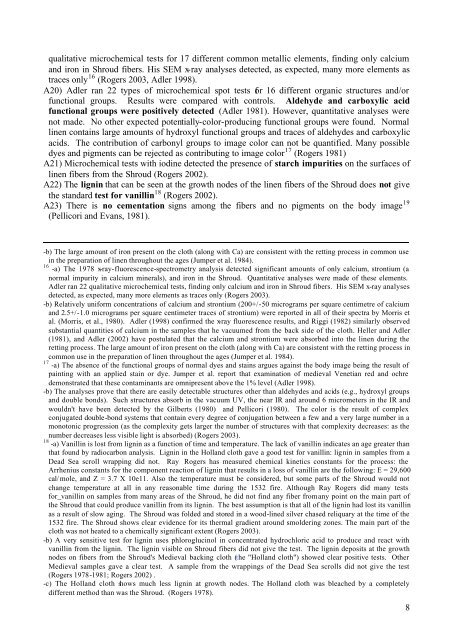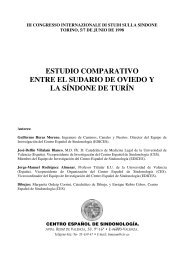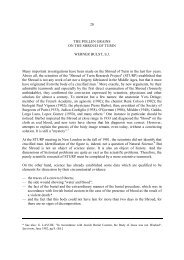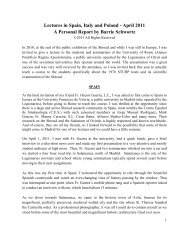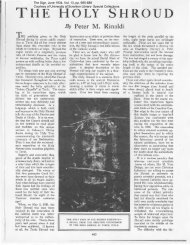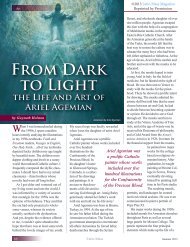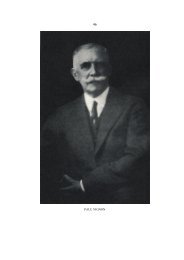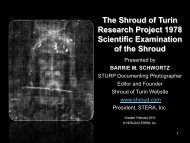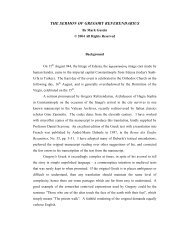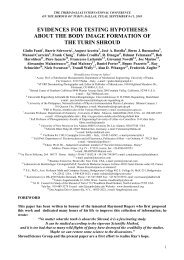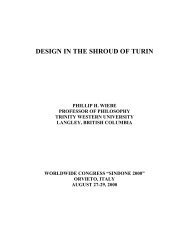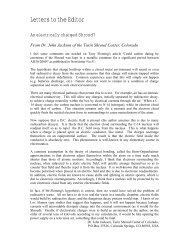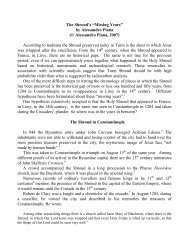list of evidences 10d Barrie - The Shroud of Turin Website
list of evidences 10d Barrie - The Shroud of Turin Website
list of evidences 10d Barrie - The Shroud of Turin Website
You also want an ePaper? Increase the reach of your titles
YUMPU automatically turns print PDFs into web optimized ePapers that Google loves.
qualitative microchemical tests for 17 different common metallic elements, finding only calciumand iron in <strong>Shroud</strong> fibers. His SEM x-ray analyses detected, as expected, many more elements astraces only 16 (Rogers 2003, Adler 1998).A20) Adler ran 22 types <strong>of</strong> microchemical spot tests for 16 different organic structures and/orfunctional groups. Results were compared with controls. Aldehyde and carboxylic acidfunctional groups were positively detected (Adler 1981). However, quantitative analyses werenot made. No other expected potentially-color-producing functional groups were found. Normallinen contains large amounts <strong>of</strong> hydroxyl functional groups and traces <strong>of</strong> aldehydes and carboxylicacids. <strong>The</strong> contribution <strong>of</strong> carbonyl groups to image color can not be quantified. Many possibledyes and pigments can be rejected as contributing to image color 17 (Rogers 1981)A21) Microchemical tests with iodine detected the presence <strong>of</strong> starch impurities on the surfaces <strong>of</strong>linen fibers from the <strong>Shroud</strong> (Rogers 2002).A22) <strong>The</strong> lignin that can be seen at the growth nodes <strong>of</strong> the linen fibers <strong>of</strong> the <strong>Shroud</strong> does not givethe standard test for vanillin 18 (Rogers 2002).A23) <strong>The</strong>re is no cementation signs among the fibers and no pigments on the body image 19(Pellicori and Evans, 1981).-b) <strong>The</strong> large amount <strong>of</strong> iron present on the cloth (along with Ca) are consistent with the retting process in common usein the preparation <strong>of</strong> linen throughout the ages (Jumper et al. 1984).16 -a) <strong>The</strong> 1978 x-ray-fluorescence-spectrometry analysis detected significant amounts <strong>of</strong> only calcium, strontium (anormal impurity in calcium minerals), and iron in the <strong>Shroud</strong>. Quantitative analyses were made <strong>of</strong> these elements.Adler ran 22 qualitative microchemical tests, finding only calcium and iron in <strong>Shroud</strong> fibers. His SEM x-ray analysesdetected, as expected, many more elements as traces only (Rogers 2003).-b) Relatively uniform concentrations <strong>of</strong> calcium and strontium (200+/-50 micrograms per square centimetre <strong>of</strong> calciumand 2.5+/-1.0 micrograms per square centimeter traces <strong>of</strong> strontium) were reported in all <strong>of</strong> their spectra by Morris etal. (Morris, et al., 1980). Adler (1998) confirmed the x-ray fluorescence results, and Riggi (1982) similarly observedsubstantial quantities <strong>of</strong> calcium in the samples that he vacuumed from the back side <strong>of</strong> the cloth. Heller and Adler(1981), and Adler (2002) have postulated that the calcium and strontium were absorbed into the linen during theretting process. <strong>The</strong> large amount <strong>of</strong> iron present on the cloth (along with Ca) are consistent with the retting process incommon use in the preparation <strong>of</strong> linen throughout the ages (Jumper et al. 1984).17 -a) <strong>The</strong> absence <strong>of</strong> the functional groups <strong>of</strong> normal dyes and stains argues against the body image being the result <strong>of</strong>painting with an applied stain or dye. Jumper et al. report that examination <strong>of</strong> medieval Venetian red and ochredemonstrated that these contaminants are omnipresent above the 1% level (Adler 1998).-b) <strong>The</strong> analyses prove that there are easily detectable structures other than aldehydes and acids (e.g., hydroxyl groupsand double bonds). Such structures absorb in the vacuum UV, the near IR and around 6 micrometers in the IR andwouldn't have been detected by the Gilberts (1980) and Pellicori (1980). <strong>The</strong> color is the result <strong>of</strong> complexconjugated double-bond systems that contain every degree <strong>of</strong> conjugation between a few and a very large number in amonotonic progression (as the complexity gets larger the number <strong>of</strong> structures with that complexity decreases: as thenumber decreases less visible light is absorbed) (Rogers 2003).18 -a) Vanillin is lost from lignin as a function <strong>of</strong> time and temperature. <strong>The</strong> lack <strong>of</strong> vanillin indicates an age greater thanthat found by radiocarbon analysis. Lignin in the Holland cloth gave a good test for vanillin: lignin in samples from aDead Sea scroll wrapping did not. Ray Rogers has measured chemical kinetics constants for the process: theArrhenius constants for the component reaction <strong>of</strong> lignin that results in a loss <strong>of</strong> vanillin are the following: E = 29,600cal/ mole, and Z = 3.7 X 10e11. Also the temperature must be considered, but some parts <strong>of</strong> the <strong>Shroud</strong> would notchange temperature at all in any reasonable time during the 1532 fire. Although Ray Rogers did many testsfor_vanillin on samples from many areas <strong>of</strong> the <strong>Shroud</strong>, he did not find any fiber from any point on the main part <strong>of</strong>the <strong>Shroud</strong> that could produce vanillin from its lignin. <strong>The</strong> best assumption is that all <strong>of</strong> the lignin had lost its vanillinas a result <strong>of</strong> slow aging. <strong>The</strong> <strong>Shroud</strong> was folded and stored in a wood-lined silver chased reliquary at the time <strong>of</strong> the1532 fire. <strong>The</strong> <strong>Shroud</strong> shows clear evidence for its thermal gradient around smoldering zones. <strong>The</strong> main part <strong>of</strong> thecloth was not heated to a chemically significant extent (Rogers 2003).-b) A very sensitive test for lignin uses phloroglucinol in concentrated hydrochloric acid to produce and react withvanillin from the lignin. <strong>The</strong> lignin visible on <strong>Shroud</strong> fibers did not give the test. <strong>The</strong> lignin deposits at the growthnodes on fibers from the <strong>Shroud</strong>'s Medieval backing cloth (the "Holland cloth") showed clear positive tests. OtherMedieval samples gave a clear test. A sample from the wrappings <strong>of</strong> the Dead Sea scrolls did not give the test(Rogers 1978-1981; Rogers 2002) .-c) <strong>The</strong> Holland cloth shows much less lignin at growth nodes. <strong>The</strong> Holland cloth was bleached by a completelydifferent method than was the <strong>Shroud</strong>. (Rogers 1978).8


